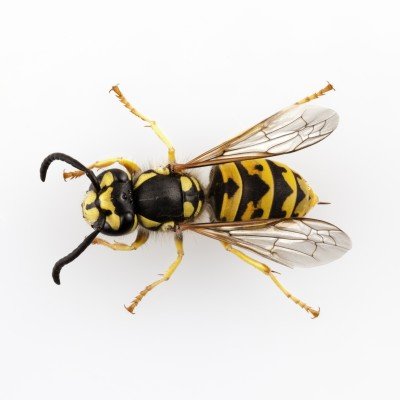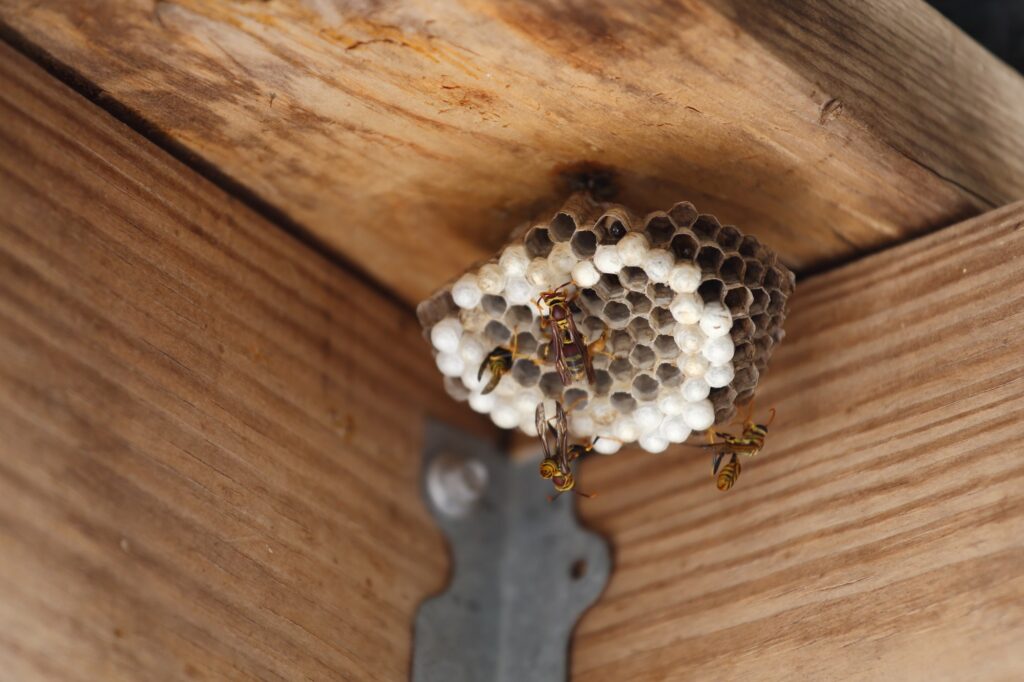
WASPS DESCRIPTION
The most commonly known wasps, such as yellowjackets and hornets, are in the family Vespidae and are eusocial, living together in a nest with an egg-laying queen and non-reproducing workers.
Biology
Wasps have four stages in their life history: egg, larva, pupa, and adult. Adult wasps have four sparsely veined, membranous wings, and most species have their abdomen joined to the thorax across a very narrow waist. Wasps have chewing mouth parts, for consuming their food and for pulping wood to paper that wasps often use to build the walls of their nests.
Wasps are relatively large insects that live in colonies of various sizes. Vespid wasps develop colonies with three castes: queens, drones, and workers. The drones are relatively short-lived males and serve only to fertilize the queens. The queens are long-lived wasps, and their major function is to initiate a colony and spend its life laying eggs. The eggs and young are tended by non-fertile female workers which are wasps that can be very numerous in large colonies. Social wasps cooperatively feed their developing young on a continuous basis, often with chewed-up insects and other animal-derived foods.
Only the queen will survive the winter. She will nest in a warm place, like under tree bark or siding. In the spring, the queen will make a new nest or may use one from the previous year, lay her eggs and begin a new colony.
Control Methods
Wasp Spray
If you have a visible hanging nest then you can use a pressurized wasp spray or foam. Make sure this treatment is performed only at night or when it is almost dark. Make sure you wear proper safety equipment. They are not likely to exit the nest, but it is best to be prepared. You want to saturate the interior of the nest first, then, once you have done this follow up by saturating the entire exterior of the nest. Leave the nest for approximately 20 minutes before removing the nest. Make sure that before you remove the nest that there isn’t any further activity. When removing, take the same precautions as mentioned earlier. Be sure to remove the entire nest, including any pieces that fall to the ground during removal.
Insect Dust
If you are treating an area where wasps are frequently traveling in and out of a hidden nest (such as in the ground or in a crack on the side of the house) you should be using an insect dust. The reason for the use of the dust over the spray in these situations is because when you spray into the cracks/holes, you aren’t necessarily spraying the nest. You are more than likely spraying the back of a wall, missing the nest completely. Instead, using a labelled insect dust allows the insect to track it back to the nest. Be sure to perform the treatment only at night, or when it is almost dark, and take the necessary safety precautions mentioned above.

Understanding Wasp Behavior and Nesting Patterns for Targeted Pest Control
Wasps have a bad reputation. With or without the misfortune of being stung by one, you know that you don’t really want them around you or your family. Our blog gives you some signs to watch out for when looking for wasps and what you can do to help prevent them from becoming a problem….

Hornet or wasp: What’s the difference?
Wasps are a common summer pest in Canada. You can often spot them hovering over garbage cans and hanging out around ice cream and hot dog stands. Although people often think wasps are exclusively yellow and black, they can be black and white, and other colours. Here’s what you need to know. How to tell…

How to Get Rid of Wasps in Your Yard and House
A swarm of wasps can quickly ruin your late-summer backyard barbeque. These buzzing insects can fall into your drinks, land on your food and buzz around your head. More than just nuisances, they can be quite dangerous. Dozens of people die each year from allergic reactions to wasp stings. Here are a few tips for…

Are Wasps Beneficial Pests?
Love them or hate them, you can count on wasps to be here every summer – drinking our drinks, eating our food, scaring our children, and stinging us in the back! Wasps are a nuisance, but are they also beneficial pests? Short Answer: Yes! Long Answer: Well… just like beauty, ‘beneficial’ is in the eye…

